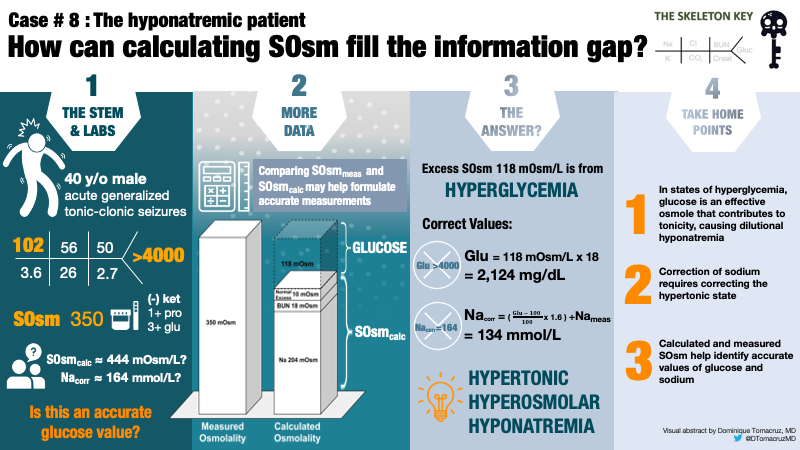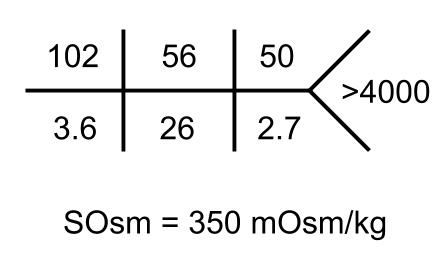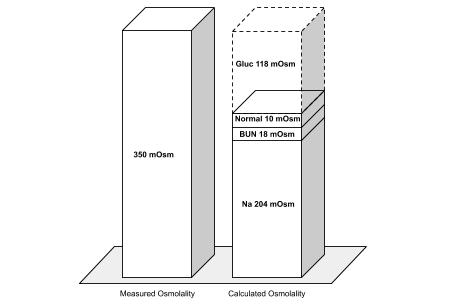It’s 1:34 p.m. and the ED pages you for hyponatremia. 📟
A 45 y/o M with no known medical history presents after a seizure with a sodium of 102 mEq/L.
#tweetorial #MedTwitter #Nephtwitter #hyponatremia @theskeletonkeygroup
What's your first move?
What is the most likely cause of hyponatremia?
Hyperglycemia-related hyponatremia is staring us in the face.👀
In insulin deficiency/hyperglycemia, glucose is “effective” osmole, drawing fluid💦from the intracellular➡️extracellular space, diluting sodium.
Glucose Up📈 , Sodium Down📉
⚠️Reminder⚠️
“Effective” osm (gluc, Na, mannitol)
-create osmotic gradient, increase tonicity, cause water to shift out of cells
“Ineffective “ osm (BUN, EtOH, glycine)
-no osmotic gradient, no change in tonicity, no water shifts
🛑Hold on…
Glucose >4000 — greater than the laboratory limit of detection.
Did our patient set a new Guinness World Record for the highest sodium? 🏆
A sodium >4000 is probably incompatible with life and likely a laboratory error.
Houston, we have a problem. 👨🏻🚀🚀🌑
Osmolality, the concentration of solute per kg of water, is used to help estimate a more accurate glucose measurement.
NA✖️ 2
BUN ➗ 2.8
Glucose ➗ 18
Can we account for all the 350 mOsm we measured?
⏳ Na 102 x 2 = 204 mOsm
⏳ BUN of 50 / 2.8 = 18 mOSm
⏳ Normal osmol gap = 10 mOsm
⏳ Glucose of ❓ = ❓
🍿POP QUIZ🍿
What is the conversion factor from mOsm/kg to mg/dL of glucose?
18 x 118 mOsms = 2,124 mg/dL 😮
Not quite the Guinness World Record glucose of 2,656 mg/dl, but certainly an impressive value and much less than the laboratory reported >4000.
To correct sodium for hypernatremia:
for every 💯mg/dL of glucose over 💯we add a correction factor #️⃣
What correction factor do you like to use?
Traditionally 1.6 is used.
Hiller et al proposed 2.4 (PMID: 10225241).
The nephrology fellows @NephBCM like @SaynaNorouzi use 2.0 to make it easy.
Using measured gluc >4000, Na corrects to >164 ❌
Using calculated gluc 2,124, Na corrects to 134 ✔️
We’ve done the mathematical heavy lifting 🏋🏿💪
This is a case of hyperglycemia-related hyponatremia in the setting of Hyperglycemic Hyperosmolar State (HHS)
1️⃣ hyperglycemia
2️⃣ hyperosmolality (>320)
3️⃣ AMS/seizure
4️⃣ absent ketones
Let’s treat the patient. 💉
With insulin, cells consume glucose, fluid shifts back from the extracellular ➡️ intracellular, correcting Na in the process.
Timing ⌚️ of correcting blood glucose is a rate of 50 - 75 mg/dL/hr per the ADA (PMID: 19564476)
So why did the patient have a seizure? 🤔
HHS may cause altered mental status, seizures, and death, but the exact pathophysiology is unclear.
Whereas rapid changes in osmolality cause cerebral edema in children 👶🏼, it very rarely occurs in adults 👴.
Idunno, bro!
In this case, the patient was admitted to ICU, received intravenous fluids and insulin per HHS protocol.
Glucose Down 📉, Sodium Up 📈
Sodium improved to 134, exactly our estimation!🤗
To summarize:
1️⃣Glucose is “effective” osmole, drawing fluid from the intracellular to the extracellular space, diluting sodium.
2️⃣Accurate measurements of serum osmolality and glucose help to predict the corrected sodium.
Special thank you to these great people, among others!
@DTomacruzMD, @amyaimei, @SaynaNorouzi, @kkalra_22, @iheartkidneys, @NephroGuy, @RyannSohaney, @drM_sudha, @kidney_boy, @TheSkeletonKG





